History
A parish church of San Pellegrino is documented at the site since 1050. A hospital, named Santa Maria della Misericordia, was founded on the site in 1240, and enlarged in 1320s by the Blessed Andrea Gallerani. The hospital was suppressed in 1408. Part of the hospital was assigned to the University of Siena, who erected the Accademia Fisiocritica (1691) with Pirro Maria Gabbrielli. In 1758, the library founded by Sallustio Bandini was opened there.
Various reconstructions of the church have occurred over the centuries. A major reconstruction occurred in 1767 under Marchetti. [1] Major works in the interior were added in the 17th century. The wall niches have six statues of Sienese saints, the ceiling is frescoed with stories of the Life of Mary, and the main altar has a painting by Giuseppe Nicola Nasini depicting the Birth of the Virgin.
Also of note in the church are earlier depictions of Blessed Andrea Gallerani attributed to the school of Simone Martini, a St Peter and Paul by Bartolomeo Bulgarini, and a 14th-century ivory triptych and icon of the Madonna di Monteguaitano, originally from the church of Maria Santissima del Rosario. Other frescoes in the church were painted by Giuliano Traballesi; canvases were present in 1840 by Lorenzo Feliciati and Jacopo Calvi, with statues by Giuseppe Mazzuoli. Underneath the church was the Oratory of the Beato Andrea Gallerrani, containing paintings by Salimbeni and Casolani. [2]

Lorenzo di Pietro, known as Vecchietta, was an Italian Sienese School painter, sculptor, goldsmith, and architect of the Renaissance. He is among the artists profiled in Vasari's Le Vite delle più eccellenti pittori, scultori, ed architettori.
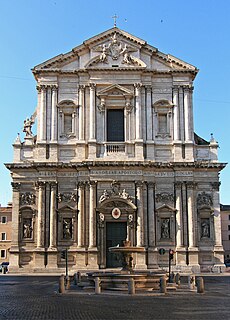
Sant'Andrea della Valle is a minor basilica in the rione of Sant'Eustachio of the city of Rome, Italy. The basilica is the general seat for the religious order of the Theatines. It is located at Piazza Vidoni, at the intersection of Corso Vittorio Emanuele and Corso Rinascimento.

The Basilica of Saint Mary of the Angels is a Papal minor basilica situated in the plain at the foot of the hill of Assisi, Italy, in the frazione of Santa Maria degli Angeli.

Santa Maria la Nova is a Renaissance style, now-deconsecrated, Roman Catholic church and monastery in central Naples. The church is located at the beginning of a side street directly across from the east side of the main post office, a few blocks south of the Church and Monastery of Santa Chiara. Today the adjacent monastery is a meeting site and hosts the Museo ARCA of modern religious art.

The Basilica della Santissima Annunziata del Vastato is the Catholic cathedral of Genoa, northern Italy; its decoration employed the major baroque studios and artists in Genoa in the 17th century.

The Basilica of Saint Nicolas of Tolentino is a Roman Catholic church and minor basilica that is part of the Augustinian monastery in the hill-town of Tolentino, province of Macerata, Marche, central Italy. The church is a former cathedral of the Roman Catholic Diocese of Tolentino, suppressed in 1586.

Giuseppe Nicola Nasini was an Italian painter of the Baroque period, active in Rome and Tuscany.

San Francesco della Vigna is a Roman Catholic church in the Sestiere of Castello in Venice, northern Italy.

Santa Maria della Scala is located in Siena, Italy. Now a museum, it was once an important civic hospital dedicated to caring for abandoned children, the poor, the sick, and pilgrims. Revenues were earned partially from bequests and donations from the citizens of Siena, particularly the wealthy. The head of the hospital was the rector who managed the lay brothers responsible for its operation.

Our Lady of Graces or Saint Mary of Graces is a devotion to the Virgin Mary in the Roman Catholic Church. Several churches with this dedication often owe their foundation to thankfulness for graces received from the Virgin Mary, and are particularly numerous in Italy, India, Australia, United States, Portugal, France and the Italian-speaking region of Switzerland. Also it is related to the Marian apparitions in which was revealed the Miraculous Medal, also known as the Medal of Our Lady of Graces.

The Basilica dell'Osservanza is a church on the outskirts of Siena, region of Tuscany, Italy.

The church of Santa Maria Assunta, known as I Gesuiti, is a religious building in Venice, northern Italy. It is located in the sestiere of Cannaregio, in Campo dei Gesuiti, not far from the Fondamenta Nuove.

San Procolo is an early Gothic-style, Roman Catholic church and former monastery-hospital located on Via Massimo D'Azeglio #52 in central Bologna, region of Emilia Romagna, Italy.

Santa Maria della Sapienza is a Roman Catholic church, located on Via Costantinopoli in central Naples, Italy.

The Sanctuary of Santa Maria della Pioggia is a small church, located on Via Riva Reno 122, between Galliera road and Riva di Reno road in central Bologna, Italy. It was once the Oratory of San Bartolomeo di Reno.
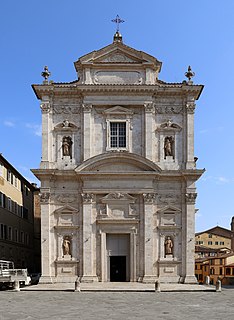
Santa Maria in Provenzano, or the Insigne Collegiata di Santa Maria in Provenzano, is a late-Renaissance-Baroque style, Roman Catholic, collegiate church in Piazza Provenzano Salvani, in the Terza Camollia, just southwest of the basilica of San Francesco, in the city of Siena, region of Tuscany, Italy. This Marian shrine was built around a 14th-century terracotta icon of the Madonna, which was credited with miracles. The Palio of Siena takes place on the day of veneration of this Marian devotion.

San Niccolò al Carmine, also called Santa Maria del Carmine is a Renaissance style, Roman Catholic church and monastery located in Pian dei Mantellini #30, near the corner of Via della Diana in the Terzo de Citta of Siena, region of Tuscany, Italy. The church now serves as the Oratory for the Contrada of Pantera. Across the street from the belltower is the Palazzo Celsi Pollini. North along Pian dei Mantellini, toward the Arco delle Due Porte, and on the same side of the street are a number of palaces built around what was once the Monastery of the Derelict Women: in order they are the Neoclassical Palazzo Incontri, the Palazzo Ravissa and the Palazzo Segardi.
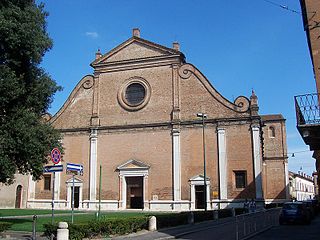
San Francesco is a late-Renaissance, Roman Catholic minor basilica church located on via Terranuova in Ferrara, Emilia-Romagna, Italy.
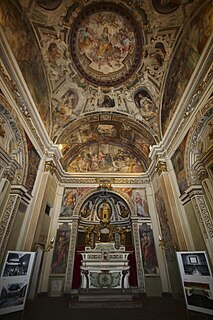
Santa Marta is a former Roman Catholic convent and church of located in the city of Siena, region of Tuscany, Italy. It now serves in part as historic archive for Siena. It is located about 30 meters downhill of the Cappella del Rosario on Via San Marco and 30 meters uphill of Porta San Marco.
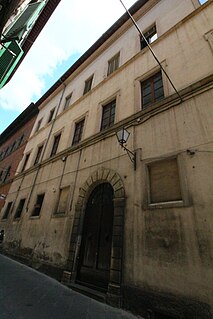
The Palazzo Venturi Gallerani is an 18th-century palace on via delle Cerchia #6, near the Pinacoteca Nazionale in Siena, Tuscany, Italy. The palace is presently occupied by private residences.





















